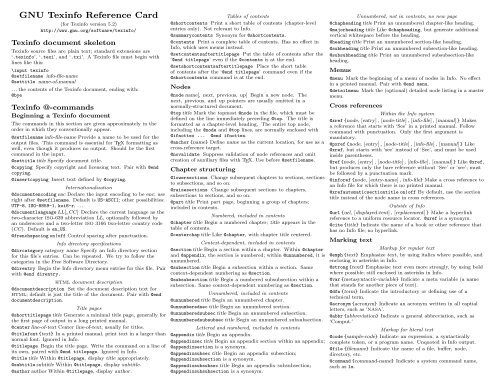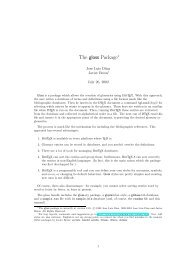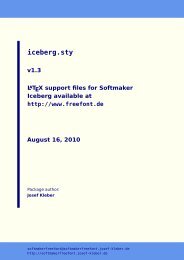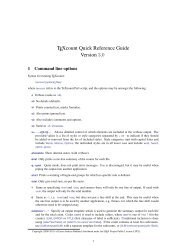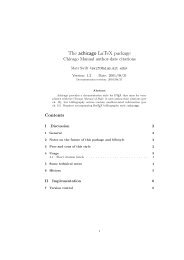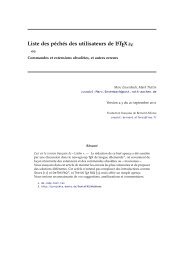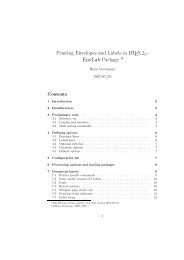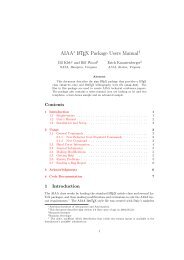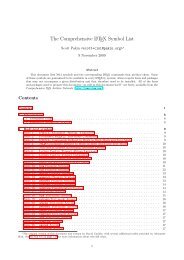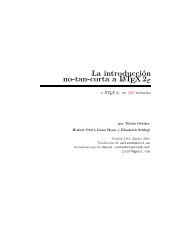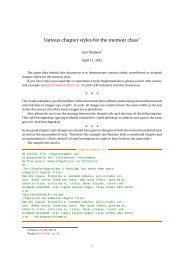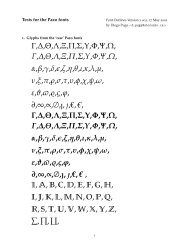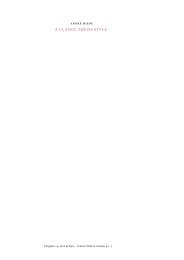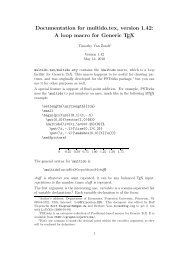GNU Texinfo Reference Card - Mirror
GNU Texinfo Reference Card - Mirror
GNU Texinfo Reference Card - Mirror
Create successful ePaper yourself
Turn your PDF publications into a flip-book with our unique Google optimized e-Paper software.
<strong>GNU</strong> <strong>Texinfo</strong> <strong>Reference</strong> <strong>Card</strong><br />
(for <strong>Texinfo</strong> version 5.2)<br />
http://www.gnu.org/software/texinfo/<br />
<strong>Texinfo</strong> document skeleton<br />
<strong>Texinfo</strong> source files are plain text; standard extensions are<br />
‘.texinfo’, ‘.texi’, and ‘.txi’. A <strong>Texinfo</strong> file must begin with<br />
lines like this:<br />
\input texinfo<br />
@setfilename info-file-name<br />
@settitle name-of-manual<br />
...the contents of the <strong>Texinfo</strong> document, ending with:<br />
@bye<br />
<strong>Texinfo</strong> @-commands<br />
Beginning a <strong>Texinfo</strong> document<br />
The commands in this section are given approximately in the<br />
order in which they conventionally appear.<br />
@setfilename info-file-name Provide a name to be used for the<br />
output files. This command is essential for TEX formatting as<br />
well, even though it produces no output. Should be the first<br />
command in the input.<br />
@settitletitle Specify document title.<br />
@copying Specify copyright and licensing text. Pair with @end<br />
copying.<br />
@insertcopying Insert text defined by @copying.<br />
Internationalization<br />
@documentencoding enc Declare the input encoding to be enc; use<br />
right after @setfilename. Default is US-ASCII; other possibilities:<br />
UTF-8, ISO-8859-1, koi8-r, ...<br />
@documentlanguage LL[_CC] Declare the current language as the<br />
two-character ISO-639 abbreviation LL, optionally followed by<br />
an underscore and a two-letter ISO 3166 two-letter country code<br />
(CC). Default is en_US.<br />
@frenchspacingon|off Control spacing after punctuation.<br />
Info directory specifications<br />
@dircategory category name Specify an Info directory section<br />
for this file’s entries. Can be repeated. We try to follow the<br />
categories in the Free Software Directory.<br />
@direntry Begin the Info directory menu entries for this file. Pair<br />
with @end direntry.<br />
HTML document description<br />
@documentdescription Set the document description text for<br />
HTML; default is just the title of the document. Pair with @end<br />
documentdescription.<br />
Title pages<br />
@shorttitlepagetitle Generate a minimal title page, generally for<br />
the first page of output in a long printed manual.<br />
@centerline-of-text Center line-of-text, usually for titles.<br />
@titlefont{text} In a printed manual, print text in a larger than<br />
normal font. Ignored in Info.<br />
@titlepage Begin the title page. Write the command on a line of<br />
its own, paired with @end titlepage. Ignored in Info.<br />
@titletitle Within @titlepage, display title appropriately.<br />
@subtitlesubtitle Within @titlepage, display subtitle.<br />
@authorauthor Within @titlepage, display author.<br />
Tables of contents<br />
@shortcontents Print a short table of contents (chapter-level<br />
entries only). Not relevant to Info.<br />
@summarycontents Synonym for @shortcontents.<br />
@contents Print a complete table of contents. Has no effect in<br />
Info, which uses menus instead.<br />
@setcontentsaftertitlepage Put the table of contents after the<br />
‘@end titlepage’ even if the @contents is at the end.<br />
@setshortcontentsaftertitlepage Place the short table<br />
of contents after the ‘@end titlepage’ command even if the<br />
@shortcontents command is at the end.<br />
Nodes<br />
@node name[, next, previous, up] Begin a new node. The<br />
next, previous, and up pointers are usually omitted in a<br />
normally-structured document.<br />
@toptitle Mark the topmost @node in the file, which must be<br />
defined on the line immediately preceding @top. The title is<br />
formatted as a chapter-level heading. The entire top node,<br />
including the @node and @top lines, are normally enclosed with<br />
@ifnottex ... @end ifnottex.<br />
@anchor{name} Define name as the current location, for use as a<br />
cross-reference target.<br />
@novalidate Suppress validation of node references and omit<br />
creation of auxiliary files with TEX. Use before @setfilename.<br />
Chapter structuring<br />
@lowersections Change subsequent chapters to sections, sections<br />
to subsections, and so on.<br />
@raisesections Change subsequent sections to chapters,<br />
subsections to sections, and so on.<br />
@part title Print part page, beginning a group of chapters;<br />
included in contents.<br />
Numbered, included in contents<br />
@chaptertitle Begin a numbered chapter; title appears in the<br />
table of contents.<br />
@centerchaptitle Like @chapter, with chapter title centered.<br />
Context-dependent, included in contents<br />
@sectiontitle Begin a section within a chapter. Within @chapter<br />
and @appendix, the section is numbered; within @unnumbered, it is<br />
unnumbered.<br />
@subsection title Begin a subsection within a section. Same<br />
context-dependent numbering as @section.<br />
@subsubsection title Begin a numbered subsubsection within a<br />
subsection. Same context-dependent numbering as @section.<br />
Unnumbered, included in contents<br />
@unnumberedtitle Begin an unnumbered chapter.<br />
@unnumberedsectitle Begin an unnumbered section.<br />
@unnumberedsubsectitle Begin an unnumbered subsection.<br />
@unnumberedsubsubsec title Begin an unnumbered subsubsection.<br />
Lettered and numbered, included in contents<br />
@appendixtitle Begin an appendix.<br />
@appendixsectitle Begin an appendix section within an appendix;<br />
@appendixsection is a synonym.<br />
@appendixsubsec title Begin an appendix subsection;<br />
@appendixsubsection is a synonym.<br />
@appendixsubsubsec title Begin an appendix subsubsection;<br />
@appendixsubsubsection is a synonym.<br />
Unnumbered, not in contents, no new page<br />
@chapheadingtitle Print an unnumbered chapter-like heading.<br />
@majorheadingtitle Like @chapheading, but generate additional<br />
vertical whitespace before the heading.<br />
@headingtitle Print an unnumbered section-like heading.<br />
@subheadingtitle Print an unnumbered subsection-like heading.<br />
@subsubheading title Print an unnumbered subsubsection-like<br />
heading.<br />
Menus<br />
@menu Mark the beginning of a menu of nodes in Info. No effect<br />
in a printed manual. Pair with @end menu.<br />
@detailmenu Mark the (optional) detailed node listing in a master<br />
menu.<br />
Cross references<br />
Within the Info system<br />
@xref{node, [entry], [node-title], [info-file], [manual]} Makes<br />
a reference that starts with ‘See’ in a printed manual. Follow<br />
command with punctuation. Only the first argument is<br />
mandatory.<br />
@pxref{node, [entry], [node-title], [info-file], [manual]} Like<br />
@xref, but starts with ‘see’ instead of ‘See’, and must be used<br />
inside parentheses.<br />
@ref{node, [entry], [node-title], [info-file], [manual]} Like @xref,<br />
but produces only the bare reference without ‘See’ or ‘see’; must<br />
be followed by a punctuation mark.<br />
@inforef{node, [entry-name], info-file} Make a cross reference to<br />
an Info file for which there is no printed manual.<br />
@xrefautomaticsectiontitle on|off By default, use the section<br />
title instead of the node name in cross references.<br />
Outside of Info<br />
@url{url, [displayed-text], [replacement]} Make a hyperlink<br />
reference to a uniform resource locator. @uref is a synonym.<br />
@cite{title} Indicate the name of a book or other reference that<br />
has no Info file; no hyperlink.<br />
Marking text<br />
Markup for regular text<br />
@emph{text} Emphasize text, by using italics where possible, and<br />
enclosing in asterisks in Info.<br />
@strong{text} Emphasize text even more strongly, by using bold<br />
where possible; still enclosed in asterisks in Info.<br />
@var{metasyntactic-variable} Indicate a meta variable (a name<br />
that stands for another piece of text).<br />
@dfn{term} Indicate the introductory or defining use of a<br />
technical term.<br />
@acronym{acronym} Indicate an acronym written in all captial<br />
letters, such as ‘NASA’.<br />
@abbr{abbreviation} Indicate a general abbreviation, such as<br />
‘Comput.’<br />
Markup for literal text<br />
@code{sample-code} Indicate an expression, a syntactically<br />
complete token, or a program name. Unquoted in Info output.<br />
@file{filename} Indicate the name of a file, buffer, node,<br />
directory, etc.<br />
@command{command-name} Indicate a system command name,<br />
such as ls.
@env{environment-variable} Indicate an environment variable<br />
name, such as PATH.<br />
@option{option-name} Indicate a command-line option, such as<br />
-v and --help.<br />
@kbd{keyboard-characters} Indicate characters of input to be<br />
typed by users.<br />
@key{key-name} Indicate the name of a key on a keyboard.<br />
@email{address, [displayed-text]} Indicate an email address.<br />
@indicateurl {url} Indicate a uniform resource locator, but<br />
without creating any hyperlink.<br />
@samp{text} Indicate a sequence of literal characters, in general.<br />
Quoted in Info output.<br />
@verb{delimchar literal-text delimchar} Output literal-text,<br />
delimited by the single character delimchar, exactly as is,<br />
including any whitespace or <strong>Texinfo</strong> special characters. Example:<br />
@verb{|@ @}|}.<br />
GUI sequences<br />
@clicksequence {action @click{} action ...} Represent a<br />
sequence of GUI actions or clicks.<br />
@click{} Represent a single ‘click’ in a @clicksequene.<br />
@clickstyle@cmd Execute @cmd for each @click; default is<br />
@arrow. Empty braces usually following @cmd are omitted here.<br />
@arrow{} Insert a right arrow glyph, →.<br />
Math<br />
@math{math} Format the given math (inline); \ becomes an<br />
escape character, and all TEX math is available.<br />
@minus{} Insert a minus sign, ‘−’.<br />
@\ Inside @math, insert a math backslash, \.<br />
@geq{} Insert a greater-than-or-equal sign, ≥.<br />
@leq{} Insert a less-than-or-equal sign, ≤.<br />
Explicit font selection<br />
@sc{text} Set text in a small caps font in printed output, and<br />
uppercase in Info. No other font command has any effect in Info.<br />
@r{text} Set text in the regular roman font.<br />
@i{text} Set text in an italic font.<br />
@slanted{text} Set text in a slanted (oblique) font if possible.<br />
@b{text} Set text in a bold font.<br />
@sansserif{text} Set text in a sans serif font if possible.<br />
@t{text} Set text in a fixed-width, typewriter-like font.<br />
Block environments<br />
‘Environments’ in <strong>Texinfo</strong> begin with @envname on a line of its<br />
own and continue through the following lines of input until the<br />
corresponding @end envname is seen.<br />
@noindent Omit the normal indentation when starting a new<br />
paragraph; often used after environments.<br />
@indent Insert normal paragraph indentation.<br />
@exdentline-of-text Output line-of-text without any indentation.<br />
@cartouche Highlight a block of text by drawing a box with<br />
rounded corners around it. Pair with @end cartouche. No effect<br />
in Info.<br />
Normally-filled displays using regular text fonts<br />
In these environments, the input is automatically rebroken into<br />
lines of output as usual.<br />
@quotation Fill text, indent on both left and right, retain normal<br />
text font. Often used for quoting text. Pair with @end quotation.<br />
@smallquotation Like @quotation, but select a smaller (text)<br />
font where possible. Pair with @end quotation.<br />
@indentedblock Fill text, indent on left (but not right), retain<br />
normal text font. Pair with @end indentedblock.<br />
@smallindentedblock Like @indentedblock, but select a smaller<br />
(text) font where possible. Pair with @end smallindentedblock.<br />
@raggedright Leave right end ragged, but otherwise fill text;<br />
retain normal text font. Pair with @end raggedright.<br />
Line-for-line displays using regular text fonts<br />
In these environments, each line of input is a line of output.<br />
@format Begin formatted text: do not fill, retain normal margins<br />
and normal text font. Pair with @end format.<br />
@smallformat Like @format, but select a smaller (text) font where<br />
possible. Pair with @end smallformat.<br />
@display Begin displayed text: do not fill, but indent text on<br />
left; retain normal text font. Pair with @end display.<br />
@smalldisplay Like @display, but select a smaller (text) font<br />
where possible. Pair with @end smalldisplay.<br />
@flushleft Left justify lines, leaving the right end ragged: do<br />
not fill text, retain normal margins and normal text font. Pair<br />
with @end flushleft.<br />
@flushright Right justify lines, leaving the left end ragged: do<br />
not fill text, retain normal margins and normal text font. Pair<br />
with @end flushright.<br />
Displays using fixed-width fonts<br />
In these environments also, each line of input is a line of output.<br />
@example Begin an example. Indent text, do not fill, and select<br />
fixed-width font. Pair with @end example.<br />
@smallexample Like @example, but where possible, print text in a<br />
smaller font. Pair with @end smallexample.<br />
@lisp Like @example, but specifically for an example of Lisp code.<br />
Pair with @end lisp.<br />
@smalllisp Begin an example specifically of Lisp code; same<br />
effects as @smallexample. Pair with @end smalllisp.<br />
@verbatim Output the text of the environment exactly as is,<br />
without indentation. Pair with @end verbatim.<br />
Lists and tables<br />
@itemizemark-command Begin an unordered list, using @item for<br />
each entry, which consist of indented paragraphs, with a mark<br />
such as @bullet inside the left margin at the beginning of each<br />
item. Pair with @end itemize.<br />
@enumerate[number-or-letter] Begin a numbered list, using @item<br />
for each entry. Optionally, start list with number-or-letter and<br />
count from there; by default, number consecutively from ‘1’. Pair<br />
with @end enumerate.<br />
@table formatting-command Begin a two-column table<br />
(description list), using @item for each entry. Write each first<br />
column entry on the same line as @item. formatting-command is<br />
applied to each first column entry. Pair with @end table.<br />
@ftableformatting-command Like @table, but automatically<br />
enter each first column entry in the function index.<br />
@vtableformatting-command Like @table, but automatically<br />
enter each first column entry in the variable index.<br />
@multitablecolumn-width-spec Begin multi-column table; start<br />
rows with @item or @headitem. Pair with @end multitable.<br />
@tab Separate columns in a row of a multitable.<br />
@item Begin an item for the list and table commands.<br />
@itemx Used only with @table. Like @item but do not generate<br />
extra preceding vertical space. When several items have the same<br />
description, use @item for the first and @itemx for the rest.<br />
@headitem Used only for multitables. Like @item, but indicates a<br />
heading row.<br />
@headitemfont{text} Set text in the heading row font.<br />
@asistext Prints text as-is; used as formatting-command for<br />
tables when no highlighting is desired.<br />
Floating displays<br />
@float Environment enclosing material which can float. Pair<br />
with @end float.<br />
@listoffloats Generate a list of floats for a given float type.<br />
@caption Define the full caption for a @float anywhere in the<br />
float environment.<br />
@shortcaption Define the short caption for a @float, used in the<br />
list of floats.<br />
@image{filename, [width], [height], [alt], [ext]} Include graphics<br />
image in external filename scaled to the given width and/or<br />
height, using alt text and looking for ‘filename.ext’ first. Can<br />
occur inline or by itself on the page.<br />
Footnotes<br />
@footnote{text-of-footnote} Insert a footnote: text-of-footnote is<br />
printed at the bottom of the page by TEX, while Info and others<br />
may format at either (by default) the end of the current node, or<br />
in a separate node.<br />
@footnotestylestyle Specify footnote style: ‘end’ or ‘separate’.<br />
Indices<br />
@cindexentry Add entry to the index of concepts.<br />
@findexentry Add entry to the index of functions.<br />
@vindexentry Add entry to the index of variables.<br />
@kindexentry Add entry to the index of keys.<br />
@pindexentry Add entry to the index of programs.<br />
@tindexentry Add entry to the index of data types.<br />
@defcodeindex newidx Define a new index and its indexing<br />
command (namely, @newidxindex). Format entries in this index<br />
with @code.<br />
@defindexnewidx Define a new index and its indexing command.<br />
Format entries as regular text.<br />
@syncodeindex from-index to-index Merge the contents of<br />
from-index into to-index, formatting the entries in from-index<br />
with @code.<br />
@synindexfrom-index to-index Merge the contents of from-index<br />
into to-index; no special formatting.<br />
@printindexindex-name Generate an alphabetized index (using<br />
two columns in a printed manual).<br />
Insertions within a paragraph<br />
Characters special to <strong>Texinfo</strong><br />
@@, @atchar{} Insert an at sign, ‘@’.<br />
@{, @lbracechar{} Insert a left brace, ‘{’.<br />
@}, @rbracechar{} Insert a right brace, ‘}’.<br />
@backslashchar{} Insert a typewriter backslash, \.<br />
@comma{} Insert a comma character; needed only when a literal<br />
comma would be an argument separator, as in @xref.<br />
@hashchar{} Insert a hash character, #; needed only when a<br />
literal hash would introduce a #line directive.<br />
@whitespace An @ followed by a space, tab, or newline produces a<br />
normal, stretchable, interword space.
Spacing refinements<br />
@: Tell TEX to refrain from inserting extra whitespace after an<br />
immediately preceding period, question mark, exclamation mark,<br />
or colon, as TEX normally would.<br />
@. Insert a period that ends a sentence; typically needed after an<br />
end-of-sentence capital letter.<br />
@? Insert a question mark that ends a sentence.<br />
@! Insert an exclamation point that ends a sentence.<br />
@dmn{dimension} Format a unit of measure, as in ‘12pt’. Causes<br />
TEX to insert a thin space before dimension. No effect in Info.<br />
Accents<br />
Braces are optional for the arguments to the accent commands,<br />
with the exception of @tieaccent.<br />
@"c Generate an umlaut, ö.<br />
@’c Generate an acute accent, ó.<br />
@,c Generate a cedilla accent, ç.<br />
@=c Generate a macron accent, ō.<br />
@^c Generate a circumflex (hat) accent, ô.<br />
@‘c Generate a grave accent, ó.<br />
@~c Generate a tilde accent, õ.<br />
@dotaccentc Generate a dot (over) accent, ȯ.<br />
@Hc Generate a long Hungarian umlaut accent, ő.<br />
@ogonekc Generate an ogonek diacritic, ą.<br />
@ringaccentc Generate a ring accent,˚o.<br />
@tieaccent{cc} Generate a tie-after accent, ⁀oo; argument must<br />
be given in braces.<br />
@uc Generate a breve accent, ŏ.<br />
@ubaraccentc Generate an underbar accent, ō.<br />
@udotaccentc Generate an underdot accent, ọ.<br />
@vc Generate a check (hacek) accent, ǒ.<br />
Non-English characters<br />
@AA {}, @aa{} Generate uppercase Å and lowercase å.<br />
@AE {}, @ae{} Generate uppercase Æ and lowercase æ.<br />
@DH {}, @dh{} Generate uppercase Ð and lowercase ð.<br />
@L {}, @l{} Generate uppercase ̷L and lowercase ̷l.<br />
@O {}, @o{} Generate uppercase Ø and lowercase ø.<br />
@OE {}, @oe{} Generate uppercase Œ and lowercase œ.<br />
@TH {}, @th{} Generate uppercase Þ and lowercase þ.<br />
@dotless{i|j} Generate dotless ı and j.<br />
@exclamdown{} Generate an upside-down exclamation point, ¡.<br />
@ordf {}, @ordm{} Generate a and lowercase o .<br />
@questiondown{} Generate an upside-down question mark, ¿.<br />
@ss{} Generate the German sharp-S (es-zet) letter, ß.<br />
Other text characters and logos<br />
@bullet{} Insert a large round dot, • (‘*’ in Info).<br />
@dots{} Insert an ellipsis, ‘...’.<br />
@enddots {} Insert an end-of-sentence ellipsis, ‘...’ (more<br />
following space in TEX.)<br />
@euro{} Insert the Euro currency sign,e.<br />
@pounds{} Insert the pounds sterling currency sign, £.<br />
@textdegree{} Insert the degree symbol, ˆ◦.<br />
@copyright{} Insert the copyright symbol, c○.<br />
@registeredsymbol{} Insert the registered symbol, ˆ R○.<br />
@TeX{} Insert the TEX logo.<br />
@LaTeX{} Insert the L A TEX logo.<br />
@today{} Insert the current date, in ‘1 Jan 2000’ style.<br />
@guillemetleft{} @guillemetright{} @guillemotleft{}<br />
@guillemotright @guilsinglleft{} @guilsinglright{}<br />
@quotedblbase{} @quotedblleft @quotedblright{}<br />
@quoteleft{} @quoteright{} @quotesinglbase{} Insert various<br />
quotation marks: « » « » ‹ › „ “ ” ‘ ’ ‚.<br />
Glyphs for code examples<br />
@equiv{} Indicate equivalence of two forms, ≡.<br />
@error{} Indicate an error message, error .<br />
@expansion{} Indicate the result of a macro expansion, ↦→.<br />
@point{} Indicate the position of point in a buffer, ⋆.<br />
@print{} Indicate printed output, ⊣.<br />
@result{} Indicate the result of an expression, ⇒.<br />
Making and preventing breaks<br />
@* Force a line break.<br />
@/ Generates no output, but allows a line break.<br />
@- Insert a discretionary hyphenation point.<br />
@hyphenation {hy-phen-a-ted words} Explicitly define<br />
hyphenation points.<br />
@tie{} Generate a normal interword space at which a line break<br />
is not allowed.<br />
@w{text} Disallow line breaks within text.<br />
@refill Does nothing (previously refilled and indented the<br />
preceding paragraph for Info).<br />
Vertical space<br />
@spn Skip n blank lines.<br />
@page Start a new page in a printed manual. Ignored in other<br />
formats.<br />
@needmils Start a new page in a printed manual if fewer than<br />
mils thousandths of an inch remain on the current page. Ignored<br />
in other formats.<br />
@group...@end group In TEX output, disallow page breaks in<br />
enclosed text; ignored otherwise.<br />
@vskipamount In a printed manual, insert whitespace amount.<br />
Ignored in other formats.<br />
Definition commands<br />
The ...x variant of each command is analogous to @itemx, leaving<br />
no extra space above. All definition commands must be written<br />
entirely on one line. Multiword arguments must be enclosed in<br />
braces. Descriptive text follows, ended by ‘@end defcmdname’.<br />
Function-like definitions, untyped<br />
@deffn[x] category name arguments Format a description for<br />
a function, interactive command, or similar entity that may<br />
take arguments. Its arguments are the category of entity being<br />
described, the name of this particular entity, and the entity’s<br />
arguments, if any.<br />
@defun[x] name arguments Format a description for a function;<br />
equivalent to ‘@deffn Function ...’.<br />
@defmac[x] name arguments Format a description for a macro;<br />
equivalent to ‘@deffn Macro ...’.<br />
@defspec[x] name arguments Format a description for a special<br />
form; equivalent to ‘@deffn {Special Form} ...’.<br />
Function-like definitions, typed<br />
@deftypefn[x] category data-type name arguments Like @deffn,<br />
but for typed entities.<br />
@deftypefun[x] data-type name arguments Like @defun, but for<br />
typed entities; equivalent to ‘@deftypefn Function ...’.<br />
Variable-like definitions, untyped<br />
@defvr[x] category name Format a description for any kind of<br />
variable. Its arguments are the category of the entity and the<br />
name of this particular entity.<br />
@defvar[x] name Format a description for a variable; equivalent to<br />
‘@defvr Variable ...’.<br />
@defopt[x] name Format a description for a user option;<br />
equivalent to ‘@defvar {User Option} ...’.<br />
Variable-like definitions, typed<br />
@deftypevr[x] category data-type name Like @defvr, but for<br />
typed entities.<br />
@deftypevar[x] data-type name Like @defvar, but for typed<br />
entities; equivalent to ‘@deftypevr Variable ...’.<br />
Types<br />
@deftp[x] category name attributes Format a description for a<br />
data type. Its arguments are the category, the name of the type<br />
(e.g., ‘int’), and then the attributes of objects of that type.<br />
Object-oriented entities, untyped<br />
@defop[x] category class name arguments Format a description<br />
for an operation in object-oriented programming. Its arguments<br />
are the category of the variable, the class to which it belongs, its<br />
name, and any arguments.<br />
@defmethod[x] class name arguments Format a description for<br />
method name; equivalent to ‘@defop {Method on} ...’.<br />
@defcv[x] category class name Format a description for a variable<br />
associated with a class in object-oriented programming.<br />
@defivar[x] class name Format a description for an instance<br />
variable name in object-oriented programming; equivalent to<br />
‘@defcv {Instance Variable of} ...’.<br />
Object-oriented entities, typed<br />
@deftypeop[x] category class data-type name arguments Format a<br />
description for a typed operation in object-oriented programming.<br />
@deftypemethod[x] class data-type name arguments Format a<br />
description for a typed method in object-oriented programming;<br />
equivalent to ‘@deftypeop {Method on} ...’.<br />
@deftypecv[x] category class datatype name Like @defcv, but for<br />
typed class variables.<br />
@deftypeivar[x] class data-type name Like @defivar, but for<br />
typed instance variables.<br />
Conditionally (in)visible text<br />
@commentcomment Begin a comment in <strong>Texinfo</strong>. The rest of the<br />
line is not visible in any output.<br />
@ccomment Synonym for @comment. DEL also starts a comrment.<br />
@ignore...@end ignore Text that will not appear in any output.<br />
Output formats<br />
@ifdocbook...@end ifdocbook <strong>Texinfo</strong> text to appear only in<br />
Docbook output.<br />
@ifhtml...@end ifhtml Text to appear only in HTML output.<br />
@ifinfo...@end ifinfo Text to appear in both Info and (for<br />
historical compatibility) plain text output.<br />
@ifplaintext...@end ifplaintext Text to appear only in plain<br />
text output.<br />
@iftex...@end iftex Text to appear only in the TEX output.<br />
@ifxml...@end ifxml Text to appear only in XML output.
@ifnotdocbook @ifnothtml @ifnotplaintext @ifnottex<br />
@ifnotxml...@end ifnotformat Begin text to be ignored in one<br />
output format but no others: @ifnothtml text is omitted from<br />
HTML output, etc.<br />
@ifnotinfo ...@end ifnotinfo Like the other @ifnot...<br />
commands, but omit from plain text output as well as Info.<br />
@inlinefmt{format, text} Include <strong>Texinfo</strong> text only in format<br />
output.<br />
@inlinefmtifelse {format, then-text, else-text} Include either<br />
then-text or else-text according to whether format is being<br />
output.<br />
Raw formatter text<br />
@docbook...@end docbook Enter Docbook completely.<br />
@html...@end html Enter HTML completely.<br />
@tex...@end tex Enter TEX completely (e.g., \ becomes an<br />
escape character).<br />
@xml...@end xml Enter XML completely.<br />
@inlineraw{format, text} Include raw text only in format output.<br />
Document variables<br />
@setname [string] Define the <strong>Texinfo</strong> variable name, optionally<br />
to the value string.<br />
@clearname Undefine name.<br />
@value{name} Insert the value of name.<br />
@ifsetname ...@end ifset If name is set, format enclosed text.<br />
@ifclear name ...@end ifclear If name is not set, format<br />
enclosed text.<br />
@inlineifset{name, text} If name is set, format text.<br />
@inlineifclear{name, text} If name is notset, format text.<br />
Testing for commands<br />
@ifcommanddefinedcmd ...@end ifcommanddefined<br />
Text to appear only if @cmd is defined ...<br />
@ifcommandnotdefined cmd ...@end ifcommandnotdefined<br />
... or not defined.<br />
txicommandconditionals <strong>Texinfo</strong> variable predefined to true.<br />
Defining new <strong>Texinfo</strong> commands<br />
@aliasnew=existing Make the command @new a synonym for the<br />
existing command @existing.<br />
@macromacroname {params} ...@end macro Define a new <strong>Texinfo</strong><br />
command @macroname.<br />
@unmacromacroname Undefine @macroname if it is defined.<br />
@definfoenclosenewcmd, before, after Can only be used within<br />
@ifinfo; create a new command that encloses its argument in the<br />
before and after strings.<br />
File inclusion<br />
@include filename Read the contents of <strong>Texinfo</strong> source file<br />
filename.<br />
@verbatiminclude filename Incorporate the contents of filename<br />
in the output, exactly as is (in the fixed-width font).<br />
Formatting and headers/footers for TEX<br />
@allowcodebreakstrue|false Control breaks at - and _ in TEX;<br />
default true.<br />
@finalout Omit large black rectangles at overfull lines in TEX<br />
output.<br />
@fonttextsize10|11 Change size of main body font in TEX.<br />
Paper sizes<br />
The default paper size is US letter-size, 8x11in.<br />
@smallbook Format for a 7x9.25in trim size.<br />
@afourpaper, @afivepaper Format for A4 and A5 paper sizes.<br />
@afourlatex Variant for A4 with more whitespace.<br />
@afourwide Format for A4 in landscape.<br />
@pagesizes[width][, height] Format for the explicitly given page<br />
dimensions, width by height.<br />
It is usually best to omit any of these settings from the <strong>Texinfo</strong><br />
document, thus allowing users to easily override the defaults when<br />
processing the document according to their desires.<br />
@codequoteundirected on|off Use undirected single quote for ’;<br />
default off.<br />
@codequotebacktick on|off Use backtick (standalone grave<br />
accent) for ‘; default off.<br />
@deftypefnnewline on|off Put return type on a line by itself;<br />
default off.<br />
@exampleindent indent Indent example-like environments by<br />
indent number of spaces (perhaps 0).<br />
@firstparagraphindentinsert|none Indent first paragraphs after<br />
section headings, or not.<br />
@headingson|off|single|double Turn page headings on or off,<br />
specify single-sided or double-sided page headings for printing.<br />
@kbdinputstylecode|distinct|example Specify font for @kbd:<br />
normal @code font, a distinct (slanted) typewriter font, or a<br />
distinct font only within @example and similar.<br />
@paragraphindent indent Indent paragraphs by indent number of<br />
spaces (perhaps 0); preserve source file indentation if indent is the<br />
string asis.<br />
@setchapternewpage on|off|odd Specify whether chapters start<br />
on new pages, and if so, whether on odd-numbered (right-hand)<br />
new pages; also set page headings accordingly.<br />
@urefbreakstyleafter|before|none Specify how @uref should<br />
break at special characters; default after.<br />
Ending a <strong>Texinfo</strong> document<br />
@bye End reading the <strong>Texinfo</strong> source. Any following text in the<br />
file is ignored.<br />
Finally, this meta-command doesn’t fit anywhere else:<br />
@errormsg{msg} Report msg as an error.<br />
Reading Info files<br />
There are two main Info readers: M-x info (C-h i) in <strong>GNU</strong><br />
Emacs, and the standalone info program. These basic keystrokes<br />
work in both.<br />
q<br />
H<br />
Quit Info altogether.<br />
Invoke the Info tutorial.<br />
Up Move up one line.<br />
Down Move down one line.<br />
DEL Scroll backward one screenful.<br />
SPC Scroll forward one screenful.<br />
Home,b Go to the beginning of this node.<br />
End Go to the end of this node.<br />
Page headers and footers<br />
@oddfooting[left] @| [center] @| [right]<br />
@oddheading[left] @| [center] @| [right] Specify page footings<br />
resp. headings for odd-numbered (right-hand) pages.<br />
TAB Skip to the next hypertext link.<br />
@evenfooting[left] @| [center] @| [right]<br />
RET Follow the hypertext link under the cursor.<br />
@evenheading[left] @| [center] @| [right] Specify page footings<br />
l Go back to the last node seen in this window.<br />
resp. headings for even-numbered (left-hand) pages.<br />
@everyfooting[left] @| [center] @| [right]<br />
[ Go to the previous node in the document.<br />
@everyheading[left] @| [center] @| [right] Specify page footings<br />
] Go to the next node in the document.<br />
resp. headings for every page.<br />
p Go to the previous node on this level.<br />
n Go to the next node on this level.<br />
@thischapter, @thischaptername, @thischapternum,<br />
u Go up one level.<br />
@thisfile, @thispage, @thistitle These commands are only<br />
t Go to the top node of this document.<br />
allowed in a heading or footing. They stand for, respectively,<br />
d Go to the main ‘directory’ node.<br />
the number and name of the current chapter (in the format<br />
‘Chapter 1: Title’), the current chapter name only (‘Title’), the 1...9 Pick the first...ninth item in this node’s menu.<br />
current chapter number only (‘1’), the filename, the current page 0 Pick the last item in this node’s menu.<br />
number, and the title of the document.<br />
m Pick a menu item specified by name.<br />
f Follow a cross reference specified by name.<br />
Document preferences<br />
g Go to a node specified by name.<br />
s Search forward for a specified string.<br />
{ Search for previous occurrence.<br />
} Search for next occurrence.<br />
i Search for a specified string in the index, and<br />
select the node referenced by the first entry found.<br />
I Synthesize menu of matching index entries.<br />
C-g<br />
Cancel the current operation.<br />
The <strong>Texinfo</strong> reference manual is available via info texinfo<br />
(and at http://www.gnu.org/software/texinfo/manual).<br />
Copyright c○ 2013 Free Software Foundation, Inc.<br />
for <strong>Texinfo</strong> version 5.2, 2013<br />
by Robert D. Solimeno<br />
and the <strong>Texinfo</strong> maintainers<br />
Copying and distribution of this material, with or without<br />
modification, are permitted in any medium without royalty<br />
provided the copyright notice and this notice are preserved.<br />
For printed copies of the <strong>Texinfo</strong> manual, visit<br />
http://www.gnupress.org or write to the Free Software<br />
Foundation, Inc., 51 Franklin Street, Fifth Floor, Boston, MA<br />
02110-1301 USA.


